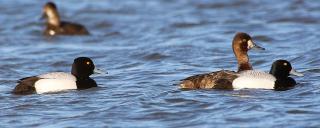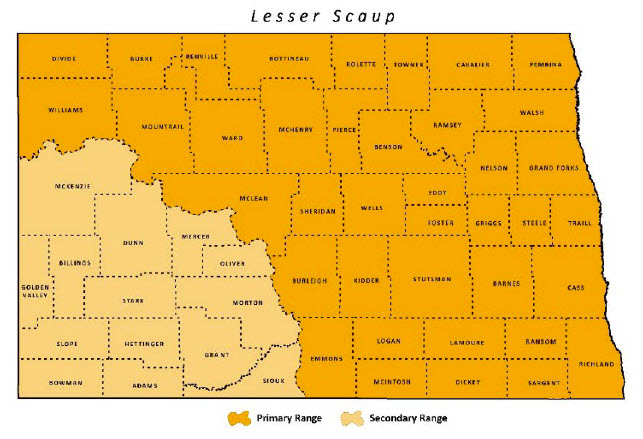

Lesser Scaup
| Scientific Name | Aythya affinis |
|---|---|
| General Description | L 16.5”, WS 25”, 1.8lb. Medium-sized diving duck, mostly black and white, with purple and green iridescence on the head, blue bill. |
| Status | Occurs in North Dakota from mid-March to November. Peak breeding season from mid-May to mid-August. |
| Abundance | Common. |
| Primary Habitat | Seasonal and semipermanent wetlands and associated uplands. |
| Federal Status | Migratory Bird. |
| Reason for Designation | Population declines began in the early 1980’s and has not rebounded even during times of improved habitat conditions. The exact cause of decline remains uncertain. Identified as a species of Moderately High Continental Priority in the North American Waterfowl Management Plan. |
Locations and Conditions of Key Habitat
Preferred Habitat
Lesser Scaup use large seasonal and semi-permanent wetlands and lakes with emergent vegetation including bulrush, cattail, and sedges. Nest over water or on the ground near water, but also in the uplands and on islands. Lesser Scaup have increased in the Prairie Pothole Region over the past several decades, possibly in part due to the addition of CRP on the landscape. Feed on aquatic invertebrates, especially chironomids and amphipods, crustaceans and mollusks.
Key Areas and Conditions for Lesser Scaup in North Dakota
No specific sites have been identified at this time. Medium-large semi-permanent wetlands in grassland dominated landscapes.
Problems Which May Affect this Species
Habitat
Conversion of grassland to cropland, energy development and urban expansion. Degradation of grasslands from invasive plants, woody encroachment, succession, and loss of diversity. Loss and degradation of wetlands and wetland consolidation limit nesting habitat and food resources.
Other Natural or Manmade Factors
Female scaup body condition has declined since the 1980’s, resulting in reduced reproductive success and population decline (Anteau and Afton 2004). Nests are parasitized by redheads and other waterfowl. Mortality from collisions with power lines and wind turbines. Expanding oil and gas development in North Dakota may impact Lesser Scaup and there is increasing risk of oilfield contamination to wetlands. Introduction of fish into wetlands alters the aquatic invertebrate and plant community.
Research and Survey Efforts
Current Research or Surveys
- Traditional waterfowl survey efforts occur annually.
- The effects of oil and gas development on waterfowl and waterfowl production is being studied in North Dakota.
- There is currently nothing specific to the species in North Dakota.
Previous Research or Surveys
- Numerous published reports and gray literature on this species throughout its range and in North Dakota. For a comprehensive list of efforts see the “Bibliography for Lesser Scaup.”
Additional Research or Surveys Needed
- Effect of drought conditions on nutrient reserves, migration, and annual recruitment.
- Determine the effects of contaminants or insecticides on wetland quality and prey species
- Contact the North Dakota Game and Fish Department Waterfowl Biologists for most current information needs.
Population and Trend Estimates

- 2014 Waterfowl Breeding Population: 4,100,000 (greater scaup too?), see figure 20
- North American Waterfowl Management Plan Objective : 6,300,000
Management Recommendations
- Preserve large tracts of grasslands and wetland complexes.
- Maintain a diversity of planted grassland on the landscape, including DNC and multi-species native grassland restoration.
- Maintain grasslands free of or with little woody vegetation.
- Restore hydrology and vegetation to degraded wetlands.
- Leave grassed buffer strips around wetlands and waterways to prevent erosion and runoff into wetlands.
- Delay cutting from April 15 – August 1, and use a stripper header and flushing bars. When cutting, leave the highest possible height (12-24 inches).
- Stocking fish in shallow wetlands is detrimental to waterfowl production.
- Utility development should follow the guidance of “Reducing Avian Collisions with Power Lines” including marking power lines and creating an Avian Protection Plan.
- Wind industry companies should collaborate with the American Wind and Wildlife Institute for responsible wind development.
Monitoring Plans
For nearly 50 years, the May Waterfowl Breeding Population and Habitat Survey have been in place. In addition, four-square mile and duck brood counts are conducted annually by the U.S. Fish and Wildlife Service. The North Dakota Game and Fish Department also conducts annual mid-July duck brood index surveys. At this time, there appears to be no additional monitoring needs.
2005-2015 Progress
The Lesser Scaup has been added as a Level II Species of Conservation Priority.

Note: A listing of works consulted when compiling the information on this page may be found in the 2015 State Wildlife Action Plan.
